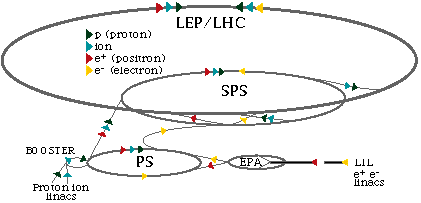
The CERN accelerator complex
CERN's accelerator complex is the most versatile in the world and represents
a considerable investment. It includes particle accelerators and colliders,
can handle beams of electrons, positrons, protons, antiprotons, and
"heavy ions" (the nuclei of atoms, such as oxygen, sulphur, and lead).
Each type of particle is produced in a different way, but then passes
through a similar succession of acceleration stages, moving from one
machine to another. The first steps are usually provided by linear
accelerators, followed by larger circular machines. CERN has 10 accelerators
altogether, the biggest being the Large Electron Positron collider (LEP)
and the Super Proton Synchrotron (SPS).

CERN's first operating accelerator, the Synchro-Cyclotron, was built in 1954,
in parallel with the Proton Synchrotron (PS). The PS is today the backbone
of CERN's particle beam factory, feeding
other accelerators with different types of particles. The 1970s saw the
construction of the SPS, at which Nobel-prize
winning work was done in the 1980s. The SPS
continues to provide beams for experiments and is also the final link
in the chain of accelerators
providing beams for the 27 kilometre LEP machine.
CERN's next big
machine, due to start operating in 2005, is the Large Hadron Collider (LHC).
For all these large projects, CERN took a series of measures to preserve the environment
 .
.


